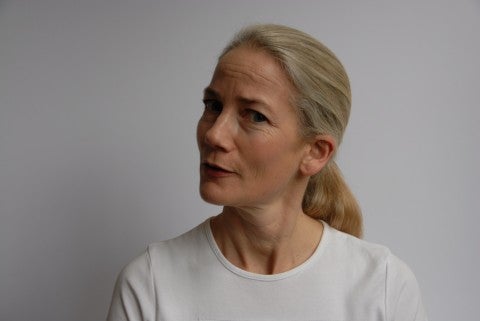Rachel Perry always has been interested in the transference, exchange, and recovery of materials. As a young girl growing up in Minnesota she established her own lending library, complete with stamps and loan records, and used her mother’s leftover fabric, boxes, and egg cartons to construct ornate houses for her dolls. Such underlying concern for re-contextualization and appropriation also informs Perry’s artistic practice in which she often saves materials that most people would, and indeed have, discarded.
It would be years later, in her late thirties, that Perry would assume a new role and become a professional artist. After studying English and French at Connecticut College, she worked as an art director at an advertising firm and was also nationally ranked as a squash player. She eventually followed in her mother’s footsteps to study and practice studio art at the School of the Museum of Fine Arts in Boston, graduating in 2001.
Perry’s early work involved the repurposing of materials accumulated while her son was in the hospital after his premature birth, such as the medical report and hospital receipt. She transcribed all 645 pages of the former onto vellum and colorfully painted the 37-page latter. After grocery shopping, Perry also collects the stickers from fruits and vegetables or the boxes and canned goods that contain them. She turns them into collages and uses them to decorate the backgrounds of large-scale photographs. Similarly, Perry has created tapestries from the twist ties that bind broccoli and leafy greens.
While she also saves her receipts, price tags, and junk mail, Perry views the exorbitant accumulation of stuff as a part of U.S. culture. In response, she launched her Deaccession Project in which she sells, recycles, throws out, or gives away one possession every day, starting with the hairbrush she discarded on October 5, 2005. To document the process, she numbers and pastes a photograph of each discarded item into an album, which ironically has amounted to nearly 2,000 images. Nonetheless, the project conveys Perry’s sentiment that, "It's the small moments that form the ballast of our lives…. Most of our lives are spent in the pursuit of the business of living. To me, it seems a natural response to pay attention to those things.” In fact, her signature work Karaoke Wrong Number (2001–04 and 2005–09) showcases just that—the “business of living”—through the purposeful, facilitative transmission of messages.
Shown in a frontal, three-quarter-length view, Perry stands before a plain white backdrop. She also wears a plain white t-shirt as she lip-synchs to messages accidently left on her telephone answering machine. In one message, a nun called to tell a priest that the choir could not possibly rehearse in a space because it was too dusty. With another, John Fodds from Big Fat Logos in Utah informs a couple that their nativity set is ready for pickup. As in her previous work, Perry recycles found media, but rather than reusing physical objects, she appropriates auditory material in the form of others’ words.
When the recordings play, Perry mouths the messages with theatrical facial gestures. During the intervals between them, she maintains a deadpan expression. Her demeanor in Karaoke Wrong Number evokes not only the business but also the drama of the (verbal) exchanges that are made in daily life. Perry also suggests that people often are animated by and rather expressive in their use of technology as it becomes commonplace. In one recording, a woman effectively gives a heartfelt apology to an answering machine in the absence of her friend.
However, as its various forms increasingly advance, technology both assists and impedes communication. On the one hand, information can be conveyed whether or not the recipient is present. When allowed to speak without response from—or interruption by—another person, one also can communicate as she pleases. She might be succinct and instructive, or see the message as an opportunity to give vent to a concern, or to prattle on endlessly.
On the other hand, as seen in Perry’s performance, one has no control over how the recipient interprets the message. Pressing matters and urgent messages become fodder for comedy in Perry’s work. Moreover, beyond art and in everyday life, the use of technology often necessarily involves clarification. A presumed innocent joke might be heard as a rude or insensitive gesture via text message, and information could be obscured or omitted in a voicemail. Even worse, or possibly better, the message could be left in error on Perry’s answering machine. –Kanitra Fletcher

